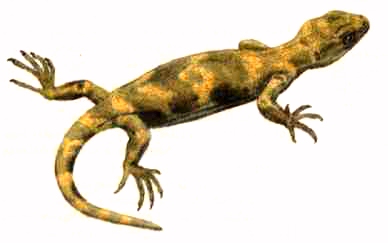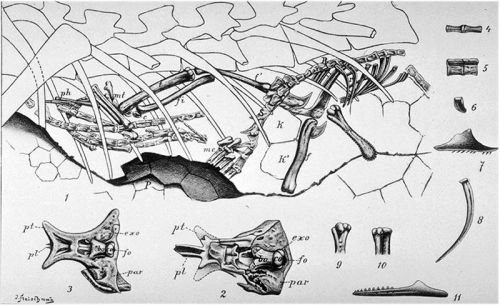
| Squamata | ||
| The Vertebrates | Scincogekkonomorpha |
| Vertebrates Home | Vertebrate | Vertebrate |
|
Abbreviated Dendrogram
Squamata
├─Iguania
└─Scincogekkonomorpha
├─ Bavarisaurus
├─ Ardeosaurus
└─┬─ Eichstaettisaurus
└─┬─ Scandensia
├─ Liushusaurus
└─Scleroglossa
├─Gekkota
╘═Scincomorpha
└─┬─Anguimorpha
└─Pythonomorpha
|
Contents
Overview |
 |
| The basal Scincogekkonomorph Ardeosaurus, Kimmeridgian of Europe. Although superficially gekko-like in appearance, this small lizard actually occupies a much more basal position in the squamatan evolutionary tree. Artwork from The Marshall Illustrated Encyclopedia of Dinosaurs and Prehistoric Animals |
During the period from the Late Jurassic to the Middle Createcous, a number of persistently primitive lizards continued to flourish alongside more advanced squamatan clades such as scincomorphs and anguimorpha. Many of these small lepidosaurs were previously classified among the gekkos, which are the most primitive and unspecilaised of the Scleroglossa, but are now known to belong on the stem of the Scincogekkonomorpha, the larger clade that includes not only extant Scleroglossans but also Mesozoic stem forms. Judging from their diversity and frequence of occurance, these basal Scincogekkonomorpha clearly played an important role in the microvertebrate ecology as terrestrial insectovores, there small size meaning that they often ended up in the stomachs of larger micro- and mesovertebrates, such as sphenodontians, small coelurosaurs, and doubtless pterosaurs and early mammals as well. MAK101106
Scincogekkonomorpha Scleroglossa > Iguania
fr midJ.
Definition:All taxa sharing a more recent common ancestor with Gekko gecko and Scincus scincus than with Iguana iguana Conrad, 2008 p.92
Squamata :Huehuecuetzpalli + Iguanomorpha + * : Bavarisaurus + (Eichstaettisaurus + Ardeosaurus + (Scandensia + Liushusaurus + Scleroglossa)).
Comments: Clade defined by Conrad, 2008 on the basis of a number of characters, and utilised by Evans & Wang 2010 for stem Scleroglossa forms. the Basal taxa include species previously considered stem-geckos (e.g. Bavarisaurus, Eichstaettisaurus) or scincomorphs or geckos (Ardeosaurus) Conrad, 2008 p.93 MAK101106
 Bavarisaurus: Bavarisaurus macrodactylus (originally Homoesaurus macrodactylus Wagner, 1852),
Bavarisaurus: Bavarisaurus macrodactylus (originally Homoesaurus macrodactylus Wagner, 1852),
Late Jur of Europe (Solnhofen limestone of Bavaria, early Tithonian)
Scincogekkonomorpha :(Eichstaettisaurus + Ardeosaurus + (Scandensia + Liushusaurus + Scleroglossa)) + *.
Comments: The only known specimen (right) reveals that these animals were among the prey of small coelurosaurs. Like Ardeosaurus and Eichstaettisaurus, Bavarisaurus was at first classified as a gekkotan, in this case on the basis of its amphicoelous vertebrae, but subsequent analyses have shown it to be a more basal form (Evans et al 2004). This reptile was about 20 cm in length
Link: Archaeopteryx and Bavarisaurus - Dinosaur art, Michael Skrepnick
Graphic: 1903 illustration by Franz Nopcsa showing Bavarisaurus in the stomach region of Compsognathus, public domain, from Wikipedia. MAK101106
 |
| Comparison of the skulls of three species of the scincogekkonomorph Eichstaettisaurus, showing the persistance of this type over an extended period of Mesozoic Europe. A. Eichstaettisaurus schroederi, Solnhofen, Germany (Early Tithonian, late Jurassic). B. Eichstaettisaurus sp. (specimen too fragmentary to describe further), Montsec, Catalonia, Spain (Berriasian, earliest Cretaceous). C. Eichstaettisaurus gouldi Evans, Raia, and Barbera 2004, Pietraroia, Italy (Albian). A, B, dorsal (top down) views, C, ventral view. Scale bars 1 mm. Graphic © from Evans et al 2004 p.403 |
Late Jur (Tithonian) to Mid Cret (Albian) of Europe
Scincogekkonomorpha :Bavarisaurus + (Ardeosaurus + (Scandensia + Liushusaurus + Scleroglossa) + *).
Comments: This long lived genus is known not only from the Tithonian of Germany and Berriasian of Spain but also the Albian of Pietraroia in Southern Italy, the three occurances represnted by distinct species. The skeleton is gracile, with limbs relatively short in relation to the presacral axial skeleton; implying this was predominantly a ground-dwelling reptile. Its presence at Pietraroia, in association with late surviving Laurasian rhynchocephalians indiccates that this was an archaic island refugium of relict Jurassic forms. The presence of a skull of Eichstaettisaurus within the stomach cavity of a Rhynchocephalian shows that these small animals sometimes fell prey to their larger lepidosaurian cousins. (Evans et al 2004). MAK101106
Link: Scipionyx and Eichstaettisaurus - artwork, Davide Bonadonna
Late Jur of Europe
Scincogekkonomorpha :Bavarisaurus + (Eichstaettisaurus + (Scandensia + Liushusaurus + Scleroglossa)) + *).
Comments: Although this small, gecko-like lizard seems to be safely included among the Scincogekkonomorpha, a more precise placement is not clear. Like the related Eichstaettisaurus, it represents an example of basal scincogekkonomorphs possessing some of the characteristics attributed to the Gekkota, an example of mosaic evolution (where primitive and advanced character states occur together. Ardeosaurus may be more basal Conrad, 2008 or more derived (Evans & Wang 2010) than Eichstaettisaurus. MAK101106
Link: Getty images
Scandensia: Scandensia ciervensis Evans & Barbadillo 1998
Early Cretaceous (Barremian) of Las Hoyas, Spain
Scincogekkonomorpha :Bavarisaurus + (Eichstaettisaurus + (Liushusaurus + Scleroglossa + *)).
Comments: Not to be confused with Scandentia (Tree Shrews), this is another basal squamate species superficially similar to gekkos, but actually much more primitive. This specialised climbing form, one of a number of primitive squamatans recovere dfrom the Las Hoyas assemblage in Spain, has been variously interpreted as being a sister taxon to living squamates Evans & Barbadillo 1998, a stem Scincogekkonomorphan (Evans & Wang 2010), or a basal Scleroglossan Conrad, 2008. It may represent a basal Scincogekkonomorpha evolving towards, or just at the very base of, the Scleroglossan crown group. According to Conrad, 2008 p.93, Eichstaettisaurus schroederi + Scandensia ciervensis + Scleroglossa form a clade that is united by a number of synapomorphies not found in the more basal genera Ardeosaurus and Bavarisaurus. MAK101107
 |
| Beautifully preserved specimen of Liushusaurus acanthocaudata, from the Jehol biota of theYixian Formation, Liaoning, Early/Middle Cretaceous, showing outline of the body, skin, and scales. Scale bar 1 cm. Photo © 2010 The Natural History Museum, from Evans & Wang 2010 p.89 |
Early/Middle Cretaceous of China
Scincogekkonomorpha : Bavarisaurus + (Eichstaettisaurus + (Scandensia + Scleroglossa + *)).
Comments: Known from a number of specimens of different growth stages, some with preservation of soft tissue impressions including scales, pigmentation, and claw sheaths. The combination of characters shows that Liushusaurus cannot be placed in any crawn groyup taxa, and instead represents a stem Scincogekkonomorphan close to the Scleroglossa. MAK101107